
CellRobot Launching Modular Robots for Futuristic Applications



Sept, 2015 – Src:Card Games has completed their first standalone card game: Src:Card. Src:Card is a two player (3-4 player with expansion) card game that pits players against each other as nation states. Each nation has one super robot with the ability to conduct global warfare. With the days of human combatants in the past, players must write code in order to defeat the all-powerful combat robots.
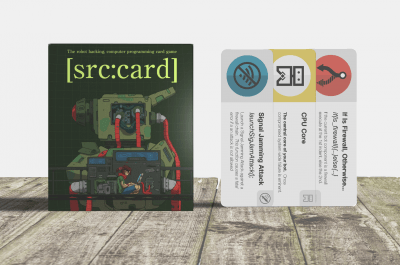
Each player alternately develops its robot’s defences and programs an attack against its opponent’s battle robot. The game uses fundamental concepts from programming in order to facilitate the attack mechanisms within the game. The dynamic nature of building robotic defences leads to a remarkably agile response from players.
Src:Card is a game of anticipation, defence and programmatic offence. The code based mechanics of the game are challenging for beginners and become more challenging as players become more adept at using the programming blocks. Src:Card was created by Sam Boychuk, Erwin Njembo and Jacob Grossman, each big fans of tabletop gaming and computer programming.
After exploring research topics in software engineering education, Sam Boychuk – lead developer – determined that academics where stressing the need to teach programming students a handful of basic concepts. Two years ago Sam decided to create a Java-based visual programming language called Pipes, as a continuation of these studies. Six months ago, the team decided that the ideas in Pipes could be better represented in a tactile standalone card game. While incorporating cutting edge research in teaching programming, Src:Card incorporates foundational computer science lessons in an effort to entertain and educate players of the game.
While it is the primary goal of the Src:Card team to entertain, they are confident that exploring foundational topics in computer science can introduce a whole new generation of technology enthusiasts to the world of software development. Erwin Njembo, a teacher and technology student stated “Src:Card is engaging, it is fun, it is competitive, it’s actually a game that keeps you on the edge, you have to use your brain all the time.” Src:Card is looking forward to releasing the game on Kickstarter immediately.
London, UK – Cannybots, the programmable smart toy robots that can be controlled from a smartphone or tablet, and that get kids excited about robotics, today launched on Kickstarter.
Cannybots are smart toy robots that encourage children to play and spend time together, rather than spending their days in front of screens playing virtual games online. Cannybots teaches kids about robotics, programming, design and 3D printing while they are playing.
Children receive a construction kit for their Cannybot containing all the parts and detailed instructions to build their robot. They can then be programmed and controlled from phone, tablet, PC or a Raspberry Pi.
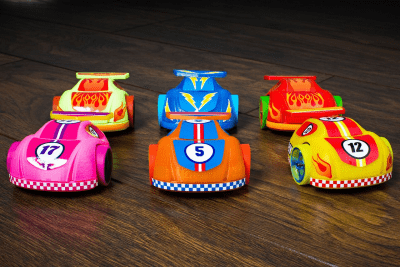
“Going through the building process gives kids the hands-on experience of building a functional robot that they can also program,” said Anish Mampetta, CEO of Cannybots. “Programming is an essential skill today but it is not easy to get kids started. We are allowing kids to do this in a fun, interactive and rewarding way.”
To introduce children to programming, the Cannybots team created a simple and intuitive app called ‘CannyTalk’. The app uses a syntax-free programming environment that works like a friendly chat tool. Using the app anyone can program the Cannybot using plain English. The complex Artificial Intelligence (AI) based engine behind CannyTalk is developed in association with researchers from the Computer Science department at the University of Cambridge in the UK.
“The children use programming to solve puzzles, control Cannybots on race tracks, and create new game play styles,” added Mampetta. “It’s an interactive, social experience that brings friends and family together.”
Once built and programmed, the bots can be used in a number of play scenarios such as high speed racing, time trials, sumo-wrestling, jousting and puzzle-solving. Apps and printable tracks are available for each game. Children can also design new car bodies using free, easy to use, browser based CAD software from Cannybots’ partner Autodesk. The designs can be then easily 3D printed using any home 3D Printer.

The current version of Cannybots is already very popular and is being used in over 20 schools in the UK and Europe.
Pre-orders start as low as $89 for an early bird special and will be shipped in time for the holidays.
For more information visit www.cannybots.com and on their Kickstarter campaign page – www.cannybots.com/kickstarter
About Cannybots
Cannybots are smart toy robots that can be controlled and programmed from a phone or a tablet. This engaging toy brings kids play time out of their tablets and back into the real world. It also introduces kids to Programming, 3D Printing and Robotics through play.
Cannybots can be used in a large number of play scenarios, such as –Racing, Sumo Wrestling, Jousting, Maze solving and other puzzle games. There is a dedicated phone app and track design for each game play. Customer can print the tracks at home or use the large format tracks that we supply. It is also possible to make a large track by printing segments of A4 sheets. The bots work by following black lines and colored mark printed on the track.
Cannybots can be programmed from a Phone or a Tablet using a simple, intuitive app called CannyTalk. It is a Natural Language based programming interface using which you can program the robot in plain simple English. It eliminates the complex Syntax found with other programming languages thus making it easy for kids to get started.
Cannybots designs are open source, free and 3D Printable. You can easily customize the design using free, browser based CAD software from our partner Autodesk. The customized designs can be 3D printed using any ordinary home 3D printer.
SAINTE-ADELE, Quebec – Sept. 22, 2015 – PRLog — InnoTechnix a robotics company, announced the launch of its new crowdfunding campaign on Kickstarter for Maximo Robot Arm. Maximo is a 5-axis robotic arm for all ages designed to be an affordable way to discover robotics.
https://www.kickstarter.com/
Maximo is our second generation of robotic arms. Three years ago, we created MandleBot, a 5-axis aluminum robotic arm currently being used in schools, robotics clubs, summer camps and even factories. We have enjoyed sharing our passion for robotics with a lot of people and it has inspired us to now do it on a larger scale. The new Maximo features a completely updated and optimized design to make it easier to use.
https://www.youtube.com/
Maximo is an Arduino-driven, 5-axis robotic arm with a laser-cut acrylic body. The robot comes with Robotic Studio, an InnoTechnix software program developed in-house that allows the user to control the arm with a gamepad or program a series of recorded steps to execute complex automations. Up to 10 robots can be connected at the same time in Robotic Studio. Maximo only requires a screwdriver to assemble and can easily be customized with attachments. Several head modules are available to expand the abilities of the arm. It is a great solution for schools to motivate students to learn more about robotics and science.
You can follow us on Facebook https://www.facebook.com/
https://www.youtube.com/
About InnoTechnix Inc.: InnoTechnix (http://www.itnx.com/
InnoTechnix previously successfully achieved a Kickstarter campaign for another robotics project. The company created a diy product inspired by the useless machine invented by MIT professor Marvin Minsky at Bell Labs in 1952. The goal was to create a product that people would assemble themselves and learn about electronics along the way. It was called the Useless Can. The campaign was successfully funded by 427 backers who pledged a total of $27,011. The idea to launch a new Kickstarter campaign for Maximo came while manufacturing the Useless Can. I realised that crowdfunding on Kickstarter had the potential to bring this longtime project of mine to a much larger scale.
San Francisco, September 24, 2015 – Robo Wunderkind is a programmable robotics kit for children of all ages. On Monday, September 21, it was launched on Kickstarter, with early bird pledges starting from just $79. Robo Wunderkind is revolutionizing how coding is taught through robotics. Kids of all ages find it easy and enjoyable to play with!
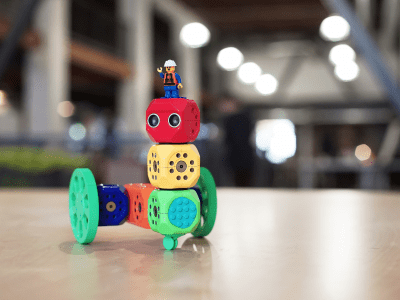
Robo Wunderkind is a set of blocks for building robots. On the outside, Robo blocks are child friendly and safely encase the sophisticated electronics contained on the inside. These electronic components transform regular blocks into programmable robotic components. By just snapping blocks together, even a five year old can build a robot. The fun doesn`t stop there: kids can playfully program the robot in an intuitive app. Modular, colorful, and LEGOTM compatible, this is the toy that opens up children`s eyes to the world of technology.
Kickstarter link: https://www.kickstarter.com/projects/startrobo/robo–wunderkind–a–programmable–robot–for–kids–of–a
Rustem Akishbekov, the founder and CEO of Robo Wunderkind, initially came up with the idea of a child-friendly programmable robot while trying to teach his friends the basic of coding and robotics. When he realized how complicated it was for new-to-programming users, he set out to make learning coding and robotics as fun and simple as playing with LEGOTM.
“We want to revolutionize the toys our kids play with, we want them to be more than pieces of plastic,” explains Rustem Akishbekov. “The LEGOTM brick hasn`t changed over 60 years while everything around it has. Now is the time for a smart toy like Robo Wunderkind that will help kids develop the skills they need for the future.”
Robo Wunderkind connects to Android and iOS devices via Bluetooth. Kids can use the app’s visual drag-and-drop interface to program it. This early learning method means that children aren´t hindered if their reading level is still developing. Once children have mastered the basics of coding, they can move on to program their robot with Scratch, a fun programming language for kids developed at MIT.

Robo Wunderkind is unique because children need not have any prior programming experience to get going. Furthermore, the cubes‘ magnet-free and secure connection system makes Robo Wunderkind stand out from the crowd. Robo Wunderkind’s innovative design has been turning heads in Europe, earning robotics award from Futurezone and the German robotics company Festo, as well as multiple startup awards.
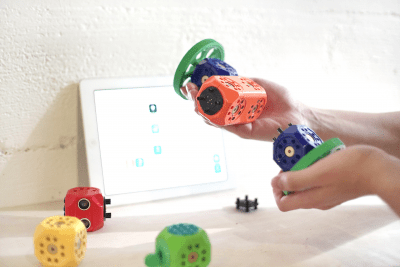
Robo Wunderkind comes in three sets. Kickstarter prices started at $79. There is a sliding price scale depending on the cube quantity and complexity. The cubes’ colors relate to their function: red is a proximity sensor, blue is a motor, orange – the main controller, and so on. The most advanced set comes with a digital camera and a weather sensor. With these special functions, your children can give weather forecasts or even surprise you with their first filming endeavors. Robo Wunderkind has been designed so that flat LEGOTM adaptors can be attached, making the blocks compatible with LEGOTM. Children can then personalize the robots they have built with LEGOTM blocks or figures.
Anna Iarotska, COO and Head of Business Development at Robo Technologies says, “Kickstarter is the perfect place to launch Robo Wunderkind, as it hosts a community of people who value innovation, creativity, and fun. We look forward to seeing what the kids out there will build with Robo Wunderkind”.
With their Kickstarter campaign, which will run until October 29, the team is hoping to raise $70,000. The funds they raise will go directly towards producing the very first batch of robots, with shipping scheduled for Summer 2016.

About Robo Technologies, Inc.
Rustem Akishbekov founded Robo Technologies, Inc and brought Anna Iarotska and Yuri Levin on board in 2013. The company is based in Vienna, Austria and San Francisco, California. The founders have gathered together a team of passionate engineers and designers who have been working on the project for two years.
In the summer of 2014, the team was part of the first worldwide hardware accelerator HAX. The progress made there was incorporated into Robo, earning them the „Robot of the Year“ Award from Festo and the Austrian Startup of the Year Award.
San Francisco, 21. September 2015 – Robo Wunderkind, ein programmierbarer Roboter-Baukasten für Kinder aller Altersgruppen, startet heute seine Kampagne auf Kickstarter. Die ersten Unterstützer erhalten ein Starterpaket für nur $79 (ca. €69).
Kindern bietet Robo Wunderkind völlig neue Möglichkeiten, die Grundkenntnisse des Programmierens mit Hilfe von Robotern einfach und spielerisch zu erlernen.
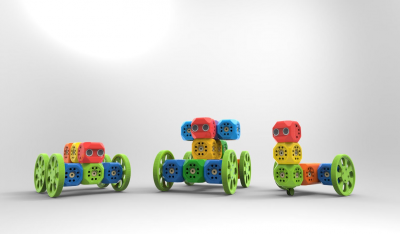
Ein Robo-Wunderkind-Set besteht aus mehreren Würfeln, aus denen sich verschiedene Roboter bauen lassen. Die Außenseite der Würfel ist kinderfreundlich und schützt die elektronischen Komponenten im Inneren, die aus den Bausteinen programmierbare Elemente machen. Die Würfel lassen sich einfach miteinander kombinieren – bereits fünf Jahre alte Kinder können so ihre eigenen Roboter konstruieren. Doch damit nicht genug: Mit einer einfach zu bedienenden App können sie dann den Roboter spielerisch programmieren. Modular, farbenfroh und mit LegoTM-Steinen kombinierbar: Robo Wunderkind ist ein Spielzeug, das Kindern eine neue Tür in die Welt der Technologie öffnet.
Den Link zur Kickstarter-Kampagne finden Sie auf http://kickstarter.startrobo.com.
Rustem Akishbekov, der Gründer und CEO von Robo Wunderkind, hatte die Idee, einen kinderfreundlichen und programmierbaren Roboter zu entwickeln, als er versuchte, seinen Freunden die Grundlagen der Robotik und des Programmierens beizubringen. Dabei realisierte er, wie kompliziert die ersten Schritte für Neueinsteiger sind – und setzte sich zum Ziel, Robotik und Programmieren so einfach, intuitiv und lustig zu machen, als würde man mit LegoTM spielen.
„Wir möchten das Spielzeug, mit dem unsere Kinder spielen, revolutionieren. Wir möchten, dass es mehr ist, als nur Plastik”, sagt Rustem Akishbekov. „LegoTM-Steine haben sich in den vergangenen 60 Jahren nicht verändert. Aber alles darum herum hat sich verändert. Es ist an der Zeit, dass wir unseren Kindern mit Hilfe von smarten Spielsachen wie Robo Wunderkind dabei fördern, die Kenntnisse zu entwickeln, die sie in Zukunft brauchen werden.“
Robo Wunderkind lässt sich mit Android und iOS-Geräten via Bluetooth verbinden. Auch Kinder, die noch nicht lesen können, können ihre Roboter mit einer App mittels Drag-and-drop Interface programmieren. Sobald Kinder ihre ersten Programmier-Schritte erfolgreich gemeistert haben, können sie ihren Roboter auch mit Scratch steuern – einer lustigen Programmiersprache, die am MIT speziell für Kinder entwickelt wurde.
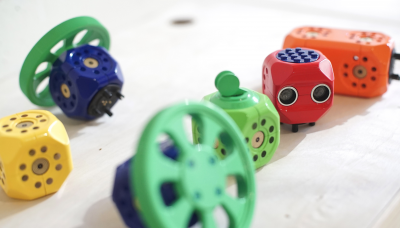
Einzigartig an Robo Wunderkind ist auch, dass Kinder keinerlei Programmier-Kenntnisse haben müssen, um loslegen zu können. Auch zeichnen Robo Wunderkind seine magnetfreien Würfel und sein sicheres Verbindungssystem aus. Das einzigartige Design hat in Europa bereits viel Aufmerksamkeit erhalten, wurde von Futurezone und der deutschen Roboter-Firma Festo ausgezeichnet, und hat mehrere Startup-Preise gewonnen.
Robo Wunderkind wird es in drei Sets geben. Preise auf Kickstarter starten bei $79 (ca. €69). Pakete mit zusätzlichen Würfeln und komplexeren Modulen werden ebenfalls erhältlich sein. Die Farbe der Würfel steht in Bezug zu ihrer Funktion: so beinhalten etwa rote Bauelemente einen Entfernungssensor, blaue einen Motor, und orange den Haupt-Controller. Das größte Set beinhaltet auch eine Digitalkamera und einen Wetter-Sensor.
Mit diesen Spezialfunktionen können Kinder zum Wetter-Forscher werden oder erste eigene Roboter-Filmprojekte starten. Robo Wunderkind wurde so entworfen, dass LegoTM-Steine und -Figuren daran befestigt werden können – so sind der Kreativität keine Grenzen gesetzt!
„Kickstarter ist die perfekte Plattform, um Robo Wunderkind zu starten. So erreichen wir eine Gemeinschaft von Menschen, die Innovation, Kreativität und Spaß wertschätzen“, sagt Anna Iarotska, COO und Leiterin des Bereichs Geschäftsentwicklung von Robo Technologies: „Wir freuen uns schon sehr darauf, zu sehen, was Kinder mit Robo Wunderkind alles bauen werden.“
Das Team hofft, durch seine Kickstarter-Kampagne, die bis 29. Oktober läuft, €62.000 ($70.000) von Unterstützern einzusammeln. Diese Mittel werden direkt in die Produktion der ersten Roboter-Generation investiert, die im kommenden Sommer ausgeliefert werden soll.
Robo Technologies GmbH
Die Robo Technologies GmbH, mit Sitz in Wien und einer Niederlassung in San Francisco, Kalifornien, wurde 2013 von Rustem Akishbekov gegründet; Anna Iarotska und Yuri Levin stießen bald danach dazu. Zusammen mit einem Team von leidenschaftlichen Entwicklern und Designern haben die Gründer in den vergangenen zwei Jahren Robo Wunderkind entwickelt. 2014 nahm das Team am weltweit ersten Hardware-Accelerator HAX teil. Die dort gesammelte Erfahrung verhalf Robo Technologies bereits zu mehreren Auszeichnungen, darunter dem “Roboter des Jahres”-Preis von Festo sowie dem “Austrian Startup of the Year”-Award.
Unsatisfied by low cost, low precision and poor functionality desktop robotic arms on the market, a group of six hardcore robot makers decided to quit their high-paying industry jobs, and build their own. Named its first product Dobot, the team’s mission is to bring industrial precision to consumer, affordable robotic arms that can actually DO the job.
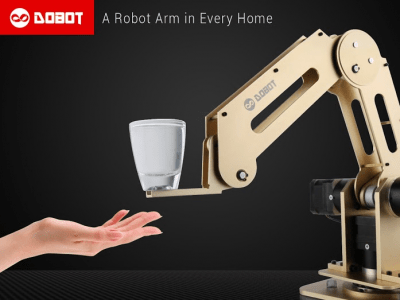
Fully designed and assembled in China, a new desktop, 4-axis, stepper motor, high precision robotic arm Dobot is launching its first Kickstarter campaign on September 15th, 2015 (Beijing Time).
The robot has tackled a series of technical difficulties struggled by other analogs. Here’s a list of its feature highlights:
For making it even more friendlier to both makers and the general public, Dobot’s design is well-fit for desktop applications, see its tech specifications:
The team has premiered its prototype at the 2015 Shenzhen Maker Faire, and has received positive feedback from makers, robot experts and open hardware communities ever since. “…the motion is really precise…it’s not just a toy, it can also be used to build stuff.” Says the CEO of Arduino, Massimo Banzi. On the popular DIY sharing platform Instrucables, its step-by-step instruction on building a robotic arm has received more than 23k likes in the first four days and got featured on the first page.
Upon their launch on Kickstarter, the team is very optimistic on the future performance of Dobot, marching their way to helping the world’s robot lovers to explore the beauty excitement of making stuff.
About the Team
The team was founded in June 2014 by a group of industrial robot engineers based in Shenzhen. The team’s CEO, Jerry (Peichao) Liu, and the head of engineering Art (Xulin) Lang both graduated from Shandong University in mechanics engineering. Jerry received its Masters from China Academy of Sciences, majoring in mechanics engineering and joined a robot company focusing on industrial robots for medical applications. Art during his Masters program, solely designed Delta parallel manipulator, Scara robot and a few others. After school, as the head of Scara robot project, he worked with Foxconn. All the founders all acquired extensive industry experience in robotics before joining the team. They have deep belief in bringing industrial precision robots to everyone’s desktop and in the future will launch a series of new models.
*Kickstarter launching on September 15, 2015 at
https://www.kickstarter.com/projects/neuronrobotics/wifi-dyio-robot-controller-w-24-channels
The WiFi DyIO (dynamic input and output device) is a wireless
micro-controller with 24 channels for robots, precision lasers, medical
equipment, 3D printers, motors, cameras, data sensors and more. With the
second generation WiFi DyIO, you can control all your devices with a
computer or Android phone—even with little programing knowledge. And
because WiFi DyIO simply coordinates the processors on your computer
wirelessly to your robot, it operates with JAVA programing language from
across the room, or around the globe.
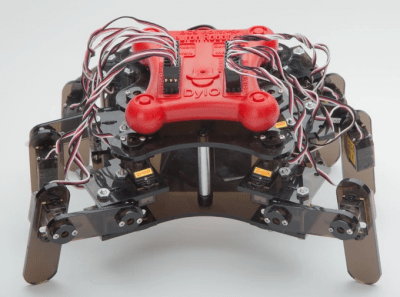
The controller works seamlessly with Neuron Robotics Cooperative’s
<https://neuronrobotics.com> free, open-source
software, BowlerStudio, which allows the virtual design and testing of
different robotics systems and parts. There are powerful modeling tools for
adept programmers, as well as easy-to-use, customizable templates for
first-time designers. Features include coordination with 3D printers to
quickly and effortlessly print custom limbs, bodies and other parts.
The DyIO/BowlerStudio system is simple and intuitive for classroom lessons
with 8-year-olds, and powerful enough for a Ph.D robotics engineer. Its
software was used to perform surgery within an MRI
<http://spectrum.ieee.org/automaton/robotics/medical-robots/inside-an-mri-a-nonmetallic-robot-performs-prostate-surgery>
and the DyIO itself is used to teach classes at Worcester Polytechnic
Institute.
DyIO and BowlerStudio have been featured on 3DPrint.com, 3ders.org and is a
semifinalist for the Hackaday Prize.
The first generation, USB-connection DyIOs are available at Microcenters
throughout the U.S. and are being used in college and grade school
classrooms. In order to take the functional WiFi-enabled prototype into
production, Neuron Robotics Cooperative is looking to Kickstarter for
$35,000.
For the average person, the word drone likely brings one of several images to mind. One of those is the Unmanned Aerial Vehicles more commonly used by the military.
People with various levels of training and intelligence can now buy various versions of „copter“ drones, depending only on their budget. What logically follows are reports of people crashing their new toys (some costing $1,000 or more) into people or buildings, perhaps a testament to how little thought has gone into the idea.
Even Amazon is toying with the idea of using drones to deliver orders of laundry detergent or whatever it is that a conventional courier service can’t get to you fast enough before you run out.
The point is, when we think of drones, we typically think about one direction and that is up.
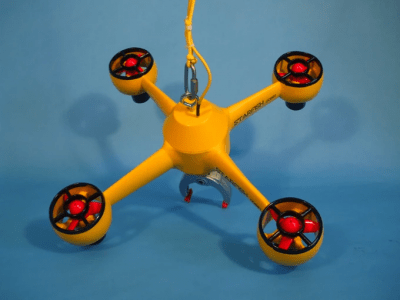
SheerTech, a Canadian industrial design company, is about to expand our directional thinking with a nifty little device that’s sure to be a hit with the underwater diving community.
It’s calling its invention the Starfish Underwater Quadradiver Robot and it won’t take you long to figure how this entirely capable device could quickly become an indispensable tool on a recreational dive boat (or any boat where fun and utility are the objective).
The Starfish—we’ll shorten the name from here on—connects its human operator on the surface with a 300-foot umbilical cord (which obviously defines how deep the device will go).
But as divers will already know, 300 feet is a long way down and there’s a good deal that can be done between the surface and that depth.
Connected to an IPad or Android device, the Starfish is naturally buoyant (which makes the surface set-up that much easier). The four 12-volt thruster motors are used to maneuver both downward and laterally and there’s a video camera as well as a maneuverable grappling hook capable of securing items weighing up to 500 pounds before the operator pulls the Starfish to the surface.
Mario Thibert, a master diver who once owned his own dive boat, is one who sees the potential of Starfish for the underwater diving community.
Writing on his website Thibert (http://www.crowdfunding-reviews.com) looked at Starfish from the diver’s perspective, and applauded the idea.
„This is not just a gadget for finding things at the bottom of the lake,“ writes Thibert. „This is a business.“
Thibert writes from experience, having owned a dive boat that operated on the St. Lawrence River, one of the busiest summer dive spots in the area off the province of Quebec, Canada.
„At the end of the day, we’d drive around in the boat near popular wrecks where there could be 150-200 divers on a weekend and we’d ‚drift‘ around where the boats would have been,“ Thibert writes. „People would drop things—a lot of stuff—when they were going down the moor line at a 45 degree angle and we’d pick up stuff like dive computers, BCDs, regulators, tanks, you name it.“
On the downside of that exercise, as divers well know, there’s a lot of work associated with just scouting around, not least of which is the need for a dive buddy.
With Starfish, trolling for treasure would become a lot easier—and potentially a lot more profitable.
Even at $2,000 per unit (the Kickstarter campaign runs until October 14) a dive community that’s accustomed to moderately hefty price tags will see the value.
Indeed, Thibert admits he paid $1,500 for a tethered camera alone.
„This is really an amazing product,“ he writes on his review site. „For a scuba diver, $2,000 is peanuts for something like this. There’s a lot of value here.“
The Starfish Underwater Quadradiver Robot is featured on Kickstarter (link https://www.kickstarter.com/projects/1066181261/starfish-underwater-quadradiver-robot).
GoBox is a GoPiGo Raspberry Pi robot with a new Mission and a new sensor delivered to your door every month, starting this Holiday 2015 season.
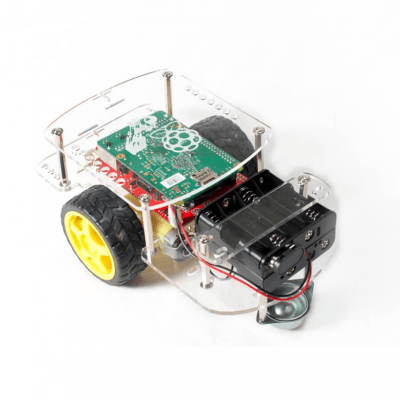
Washington, D.C. September 1, 2015 – Dexter Industries, an educational robotics company, today launched GoBox, their fourth Kickstarter project. GoBox is a monthly subscription of robot Missions that are designed for a child (ages 7 and up) to do with the help of an adult. The intent of GoBox is to make learning computer programming and technology accessible to everyone. It doesn’t require any prior knowledge of robotics, and takes you step-by-step through building your own robot and learning how to program it to do all kinds of cool things!
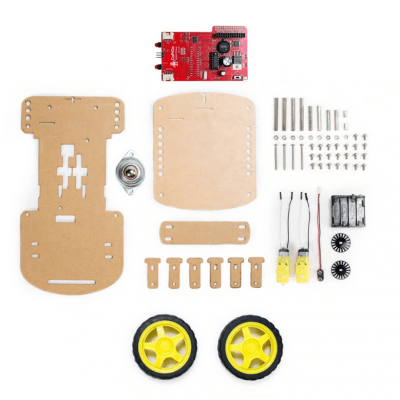
The first month’s GoBox Mission comes with a complete robot kit, the GoPiGo, for you to build and start learning how to program. The GoPiGo is based on the Raspberry Pi, a $35 single board computer developed by a UK foundation designed to teach young people how to program. Each month, subscribers will get a new sensor to attach to your GoPiGo robot, along with a Mission complete with beautiful illustrations and links to helpful videos.
This past Father’s Day, ten parent-child teams gathered at NOVA LABS, a community Makerspace in Reston, VA, to try GoBox for themselves. Parents of all skill levels worked side-by-side with their child to build their GoPiGo robot car, and decorate and program it to look and act like an animal of their choice. Within a few hours, there were cheetahs, bats, moths, and spiders crawling around the floor of the lab!
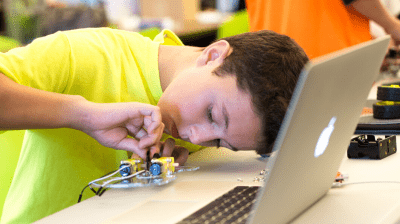
“I’ve really never done anything like this before with my son, and it was so easy and fun – I couldn’t believe it!” said participant Lily Griffin, mother of 12-year old Ryan.
Dave Bock, a software developer, came to get one of his triplets more interested in technology. “It was fun to see the creative side come out, along with learning technical concepts about motors and programming.”
Key Features of GoBox:
* No prior experience or knowledge required – beginners welcome!
* Monthly Missions that slowly build on each other and keep you engaged – the key to success!
* Missions use Scratch, an easy-to-use drag/drop language developed by MIT.

About Dexter Industries
Dexter Industries, a growing educational robotics company, was founded in 2010 by John Cole to develop products that make open source robotics technology more accessible to everyone.
GoBox Kickstarter link: www.DexterGoBox.com
More information on the GoPiGo Raspberry Pi robot car: http://www.dexterindustries.com/GoPiGo